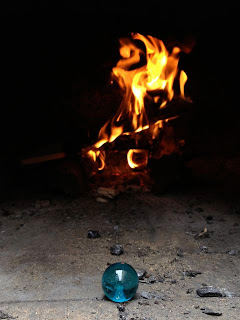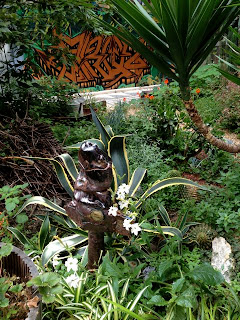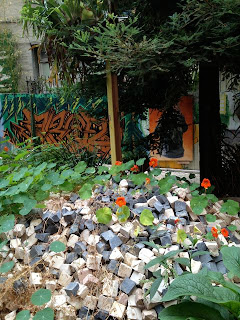You will come to a place where the streets are not marked.
Some windows are lighted, but mostly they're darked.
A place you could sprain both your elbow and chin!
Do you dare to stay out? Do you dare to go in?
How much can you lose? How much can you win?
— Dr. Seuss, "Oh The Places You'll Go!"
A group of us gathered in the Tenderloin National Forest for a site visit to 509 Ellis Street, in preparation for Rooftop Student Art Show, in conjunction with the celebration of Flo Oy Wong's 75th Birthday.
When we arrived, the clay oven was fired up. Co-Founder Darryl Smith was there to tell us more about the history of the Tenderloin National Forest and the adjacent gallery, The Luggage Store Annex.
Darryl welcomed JT, MA, Mary, Cheryl, Rittinell, Tamra, Amy and Marcus for their first visit to the Tenderloin National Forest. This magical place is a testament to art, imagination, community. An expression of love and true grit - nestled in the heart of the Tenderloin.
On the way over in the car, Flo told us the story of how Darryl came to offer this amazing opportunity to Rooftop School. When Flo and Darryl first met over a year ago to discuss her upcoming 75th Birthday celebration at the Luggage Store, she told Darryl that she would be working with our students in the classrooms. Flo came into the classrooms to share the story of her husband Ed growing up in Augusta, Georgia during the time of segregation with his best friends, Boykin and Cush. Ed's stories are embedded within her art installation, The Baby Jack Rice Story.
Darryl suggested that Rooftop might hold an art show simultaneously with Flo's 75th birthday exhibit, and offered the Luggage Store Annex to the school for the months of October & November in 2013.
Darryl passed on the information that the tiny wattle-and-daub shed was built by Rooftop parent Julia Glanville. She found all of the materials used to build this timber and woven structure locally.
Looking out from inside the Wattle-and-Daub House in the Tenderloin National Forest. A "bird nest" sculpture made of twigs and branches, hangs in the window
Darryl and I talked about some ideas that our group had discussed earlier. Might we be able to find a way for us to open up a window to invite all children in the City to participate and contribute to the upcoming Rooftop art show that will take place in October/November?
I asked him if he was familiar with Edward Steichen's 1955 exhibit and book, "The Family of Man" which displayed 503 photos by 273 artists from 68 countries.
Childhood was a central theme to the iconic show.
Darryl smiled and brought me round to the tiny wattle-and-daub shed.
The walls were lined with photos of the neighborhood residents who live in the area.
The sculpture was added later.
JT is especially curious about the new PPlanter which has recently been installed in the Forest. This PPlanter prototype is designed by Hyphae Design Lab, an ecological engineering firm. This public urinal project is is an interesting attempt to tackle a public sanitation problem.
In the PPlanter the urine is sent through a 50-gallon drum of water and then pumped into a large plant container — The bamboo plant, inside the PPlanter to the right, is watered by the resulting mixture - 11 parts gray water to 1 part pee.
Darryl, JT & Amy talk about the PPlanter and other interesting experimental projects planned for the Tenderloin National Forest. There are plans to install a vertical garden here on this wall near the Forest entrance.
Art everywhere - inside the Tenderloin National Forest.
Darryl checks on the pizza, baking in the clay oven.
Amara slices up the pizza - Fresh from the Oven!
Michael Swaine sets up the Tenderloin Mending Library once a month in the Tenderloin National Forest. He invites the neighborhood to bring their items in need of repair to the Library, where he mends things for free.
A neighbor brings a coat that needs repair.
Victor checks out Michael Swaine's much used sewing machine.
Michael carefully stitches a Tenderloin National Forest patch on my old workshirt pocket. He prefers to call himself a mender, rather than a tailor, but he does a beautiful job.
Michael used to wheel his cart through the City, but he came to settle in the Tenderloin because he found that this was the place where there were more things in need of mending. The people in the neighborhood were most appreciative and accepting of his work, as opposed to some areas where he would mend something and it would meet a critical eye.
"It is a library is for fixing the holes in our lives
— a place to borrow thread and sewing machines and talk about life."
Victor finds out that the wheels on Michael's sewing machine cart aren't working so well.
He heads back home to get his tools and promises to return and fix the cart.
The view outside from inside the gallery at the Luggage Store Annex.
The windows are like the gallery's eyes to the street.
The designs on the mosaic pathways by Rigo 23 are inspired by the Ohlone Indian tribe — the first residents of the Tenderloin.
Tamra rests in front of one of Brett Cook's murals, a portrait of Woody, a resident of the neighborhood who used to live around the corner.
After our time in at the Luggage Store Annex, we crossed the street to visit the Tenderloin Children's Playground and Center and went up to see their Rooftop Garden.
The "Safe Passage" sidewalk mural in the Tenderloin District helps children travel safely through the neighborhood. Designed by Sylvester Guard, the service project sponsored by the Chinatown Community Development Center (Chinatown CDC), the mural was painted by volunteers from the Bay Area LISC Americorps on Martin Luther King Day 2012.
Across the street, we could see that our favorite handy man Victor had made it back to the Forest with his tools. Ready to help fix Michael's wheels on the Mending Library.













































No comments:
Post a Comment